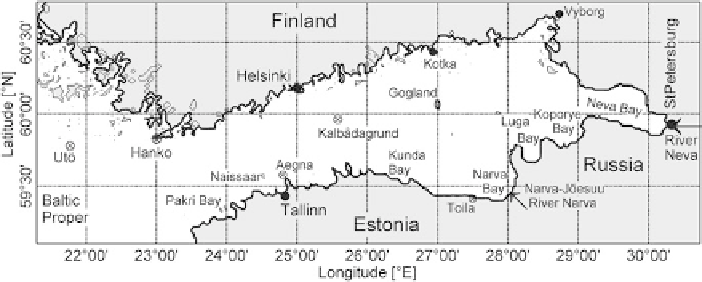Geoscience Reference
In-Depth Information
Fig. 13.2
Scheme of the Gulf of Finland
from Poland up to Latvia or bedrock-based, extremely stable archipelago areas
along the Swedish and Finnish coasts), understanding of physics and dynamics of
lithohydrodynamical processes along the coasts of the Gulf of Finland is still a chal-
lenge. The most interesting are the southern and eastern coasts of the Gulf of Finland
that belong to a rare type of young, relatively rapidly uplifting beaches. This chapter
makes an attempt to depict the basic factors jointly governing their evolution and to
make use of their closeness to the equilibrium for practical estimates of sand loss or
gain.
Different from several downlifting coasts in southern Sweden or in Denmark
that are largely open to substantial hydrodynamic loads and are rapidly developing
tively rapid postglacial uplift, the magnitude of which ranges from about 1 mm/year
in the eastern part of Estonia near Narva up to about 2.8 mm/year in the northwest-
combined with relatively low hydrodynamic activity and limited supply of sand has
led to a specific type of “almost equilibrium” beaches that develop relatively slowly.
Such a slow net development is not specific to the Baltic Sea and in many cases the
evolution of beaches is governed by highly dynamic processes (such as littoral drift
that generally carries sediments to the bayheads, supply of sediments by rivers, the
mouths of which are located at the bayheads, and the above-mentioned land uplift)
that jointly keep the beach in an equilibrium state.
The above suggests that the beaches in question eventually are extremely sensi-
tive to changes in external factors. For example, an increase of the global sea level,
increased discharge during more pronounced spring floods in the climate of the
for sustainable management of such beaches is establishing the parameters of their
equilibrium regime, the magnitude of the sediment supplies, and the basic patterns
of the natural sediment transport processes. Based on this information, well-justified

